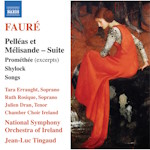Shostakovich’s “Late” Quartets
Shostakovich the man, as he appeared to the members of the Fitzwilliam Quartet nearly 53 years ago, is enshrined for all time in the music of his last four string quartets. That is not to say that these are autobiographical works, because in intention they are not really so: the feeling is altogether subtler, more spiritual even, than this. The experience of these quartets, whether through rehearsing, performing, or as a listener, really does recall being in the company of Shostakovich himself: the personality of the man and his music seem to be as one, and it is the very nature of this personality which makes the experience so profound and special, and so much in harmony with the essentially personal and intimate world of the String Quartet.
Dividing a body of music, or a composer’s life, into “sets” or “periods” can be partly a matter of convenience, especially useful for today’s packaging and marketing methods. Composers themselves may not always be aware when they are undergoing change, but from our vantage point we are able to see a whole career in one glance and thus can readily detect stylistic shift. Beethoven made it easy for us by taking a lengthy sabbatical. No such fallow period occurred in Shostakovich’s life; and neither did he adopt an entirely new system of composition, as did Stravinsky in old age. The dividing line is blurred and therefore arbitrary – to a certain extent. But listeners will surely be able to hear that the twelfth quartet sounds different from, say, the fourth, and may want to understand why, or to find his/her bearings in this prolific output.
There are two special characteristics which most of Shostakovich’s late works share. The first, ironically, parallels Stravinsky in that twelve-note rows became a feature. The other relates more to Schubert, whose last years were dominated by an awareness and fear of approaching doom, hastened by irreversible physical disease. We have already heard how the seventh and eighth quartets grew out of Shostakovich’s first hand contact with death, and how this affected their musical language and content. But from the demise of his father in 1922, up to that time of life when advanced age inevitably takes its toll on one’s contemporaries, it refused to go away: not only did he suffer the loss of his wife Nina, but for a long period he had to endure the disappearance of many friends and colleagues. Yet he never really learned to come to terms with death. That first big heart attack would surely have been the real blow; with his earlier medical record he must have dreaded what a further one might bring…. And here lies the psychological root of these last compositions: Death had coloured his music on many previous occasions, but the crucial difference now was that it was his own death he had to contemplate. Like Beethoven, and Mahler, and Schubert, his final period of creativity was strongly coloured by musings on his own mortality. But whereas Beethoven (we gather) was able to regard his considerable suffering as only a temporary handicap, such faith held no meaning for Shostakovich, who saw death as something absolutely final. The picture of anguish and terror which emanates from such works as Quartets 13 and 15 is harrowing indeed – and almost too explicit in the fourteenth symphony, which represented the most open manifestation of all these thoughts.
Significantly, the changing musical language of the composer’s final period is also seen at its most advanced in this particular symphony. During the sixties Shostakovich’s melodic style had gradually assumed more chromatic freedom, although still embedded in essentially tonal harmony. But at length he must have felt the need to break away from the security of tonality; the formal device of using “twelve notes related only to each other” (Schönberg) represented a decisive step. However, it is important to understand from the outset that at no time does Shostakovich adopt Schönberg’s serial technique; rather, his note-rows are manipulated precisely to suit specific formal and expressive requirements; and, as these requirements change from work to work, so the technique must necessarily be flexible as well.
It would be easy to draw parallels with Beethoven in discussing these “’late” quartets, and their common points of reference. But the fourteen years which separated his Op.95 and Op.127 quartets were far from mirrored in Shostakovich’s catalogue, which from 1956 until his death averaged one quartet every two years; neither was there the same exclusive concentration on the medium towards the end of his life. Yet, despite the stylistic, emotional, and chronological bonds which unite all the outwardly diverse works of this period, it is the last four quartets which do seem to form their own peculiarly intimate relationship within the larger company: they belong very much to each other, presenting four entirely contrasting aspects of something common to them all.
© Alan George


















